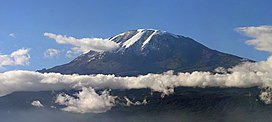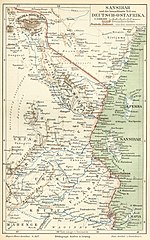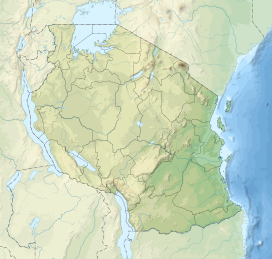Mount Kilimanjaro: Difference between revisions
m Reverted edits by 88.210.150.140 (talk) to last version by Viewfinder |
|||
| Line 64: | Line 64: | ||
==Name== |
==Name== |
||
Kilimanjaro name is a combination of two |
Kilimanjaro name is a combination of two German words, '''Kilemia''', '''ngaruo''' meanining difficult to climb. The Chagga are native agriculturalists on the slopes of Kilimanjaro. The mountain has three peaks, '''Kibo''', '''Mawenzi''' and '''Shira'''. The names are also Chagga words, Kibo from '''Kifwo''' in Chagga which means '''present''', Mawenzi from '''Kimawenje''' meaning brocken and '''Shira''' meaning '''war''' as it was a platform for fighting with the Maasai. The names predate the sighting of the mountain by the Germans explorers. Kibo is sometimes hidden by clouds in the evening but is visible in the morning. Kibo is a landmark for those travelling to and from the coast and when they arrive in Moshi at the foot of the mountain during the evening would not see the peak until morning of the following day. The residents miss to see the peak during the evening but will see it during the morning. Kibo for the travellers translated to the kiswahili term '''kipo''' with the same meaning '''it is present'''. Njau M. A. UDSM Tanzania |
||
[[File:Meyers b14 s0300a.jpg|thumb|150px|Historical map with "''Kilima-Ndscharo''" in [[German East Africa]], 1888]] |
[[File:Meyers b14 s0300a.jpg|thumb|150px|Historical map with "''Kilima-Ndscharo''" in [[German East Africa]], 1888]] |
||
Revision as of 18:08, 24 February 2010
| Kilimanjaro | |
|---|---|
 Kibo Summit of Kilimanjaro | |
| Highest point | |
| Elevation | 5,893 metres (19,334 ft)[1] |
| Prominence | 5,882 m (19,298 ft) Ranked 4th |
| Isolation | 5,510 km (3,420 mi) |
| Listing | Seven Summits Country high point Ultra |
| Coordinates | 03°04′52″S 37°21′29″E / 3.08111°S 37.35806°E |
| Geography | |
| Location | Tanzania |
| Topo map | Kilimanjaro map and guide by Wielochowski [2] |
| Geology | |
| Mountain type | Stratovolcano |
| Last eruption | None in recorded history |
| Climbing | |
| Easiest route | hike |
Kilimanjaro, with its three volcanic cones, Kibo, Mawenzi, and Shira, is an inactive stratovolcano in north-eastern Tanzania and the highest mountain in Africa at 5,895 metres or 19,341 feet (the Uhuru Peak).[3] Mount Kilimanjaro is considered to be the tallest freestanding mountain in the world, rising 4600 m (15,100 feet) from the base.
The exact meaning and origin of the name Kilimanjaro is unknown. It is thought to be a combination of the Swahili word Kilima (meaning "mountain") and the Kichagga word Njaro, loosely translated as "whiteness", giving the name White Mountain. The name Kibo in Kichagga means "spotted" and refers to rocks seen on snowfields. The Swahili word Uhuru translates as "freedom", a name given to commemorate Tanzanian independence from Great Britain in 1961.
Climatic conditions
Kilimanjaro is the highest mountain in Africa and fourth highest of the Seven Summits. It is considered the tallest freestanding mountain in the world, with Uhuru Peak rising to an altitude of 15,100 feet (4,600 m) from base to summit.
Kilimanjaro is composed of three distinct volcanic cones: Kibo 19,340 feet (5895 meters); Mawenzi 16,896 feet (5149 m); and Shira 13,000 feet (3962 m). Uhuru Peak is the highest summit on Kibo's crater rim.
Kilimanjaro is a giant stratovolcano that began forming a million years ago, when lava spilled from the Rift Valley zone. Two of its three peaks, Mawenzi and Shira, are extinct while Kibo (the highest peak) is dormant and could erupt again. The last major eruption has been dated to 360,000 years ago, while the most recent activity was recorded just 200 years ago. Kilimanjaro has 2.2 square kilometres (0.85 sq mi) of glacial ice and is losing it quickly due to climate change. The glaciers have shrunk 82% since 1912 and declined 33% since 1989. It might be ice free within 20 years, dramatically affecting local drinking water and crop irrigation.[citation needed]
Volcanic conditions
Although it is inactive, Kilimanjaro has fumaroles that emit gas in the crater on the main summit of Kibo. Scientists concluded in 2003 that molten magma is just 400 m (1,310 ft) below the summit crater. Several collapses and landslides have occurred on Kibo in the past, one creating the area known as the Western Breach.

Mapping
Early good maps of Kilimanjaro were published by the British Government's Directorate of Overseas Surveys (DOS 422 Y742) in 1963. These were based on air photography carried out as early as 1959 by the RAF. These were on a scale of 1:50,000 with contours at 100 ft intervals. These are now unavailable. Tourist mapping was first published by the Ordnance Survey in England in 1989 based on the original DOS mapping (1:100,000, 100 ft intervals, DOS 522). This is now no longer available. EWP produced a map with tourist information in 1990 (1:75,000, 100 m contour intervals, inset maps of Kibo and Mawenzi on 1:20,000 and 1:30,000 scales respectively and 50 m contour interval). This is regularly updated and in its 4th edition. In the last few years numerous other maps have become available of various qualities.[2]
EWP map sample (1:75,000, summit area).[4]
Physical features

Kilimanjaro rises[5] 4,600 m (15,092 ft) from its base, and approximately 5,100 m (16,732 ft) from the plains near Moshi.
Name
Kilimanjaro name is a combination of two German words, Kilemia, ngaruo meanining difficult to climb. The Chagga are native agriculturalists on the slopes of Kilimanjaro. The mountain has three peaks, Kibo, Mawenzi and Shira. The names are also Chagga words, Kibo from Kifwo in Chagga which means present, Mawenzi from Kimawenje meaning brocken and Shira meaning war as it was a platform for fighting with the Maasai. The names predate the sighting of the mountain by the Germans explorers. Kibo is sometimes hidden by clouds in the evening but is visible in the morning. Kibo is a landmark for those travelling to and from the coast and when they arrive in Moshi at the foot of the mountain during the evening would not see the peak until morning of the following day. The residents miss to see the peak during the evening but will see it during the morning. Kibo for the travellers translated to the kiswahili term kipo with the same meaning it is present. Njau M. A. UDSM Tanzania

It is unknown where the name Kilimanjaro originates, but a number of theories exist. European explorers had adopted the name by 1860 and reported that it was its Swahili name,[6] with Kilimanjaro breaking into Kilima (Swahili for "hill, little mountain") and Njaro,[7] whose supposed origin varies according to the theories—according to some it's an ancient Kiswahili Swahili word for white or for shining,[8] or for the non-Swahili origin, a word from the Kichagga language, the word jaro meaning "caravan". The problem with all these is that they can't explain why the diminutive kilima is used instead of the proper word for mountain, mlima. The name might be a local joke, referring to the "little hill of the Njaro" being the biggest mountain on the African continent, since this is a nearby town, and guides recount that it is the Hill of the Njaro people. A different approach is to assume that it comes from the Kichagga kilmanare or kileajao meaning "which defeats the bird/leopard/caravan". However this theory cannot explain the fact that Kilimanjaro was never used in Kichagga before in Europe in the mid-1800s.[6]
In the 1880s, the mountain, at that time spelled Kilima-Ndscharo in German following the Swahili name components, became a part of German East Africa after Karl Peters had persuaded local chiefs to sign treaties (a common story that Queen Victoria gave the mountain to Kaiser Wilhelm II is not true).[9] In 1889 the peak of Kibo was named "Kaiser-Wilhelm-Spitze" ("Kaiser Wilhelm peak") by Hans Meyer, on the first ascent to the summit on 5 October 1889.[6] That name was used until 1918, when after World War I the German colonies were handed over to the British empire. When British-administered Tanganyika gained its independence in 1961, the peak was named "Uhuru peak", meaning "Freedom peak" in Swahili.
The Ki- prefix in Swahili has several underlying meanings. The old Ka- diminutive noun prefix (found now only as Kadogo - a small degree), merged with the Ki class. One of its meanings was to also describe something unique of its kind: Kilima, a single peak, as opposed to Mlima, which would better describe a mountain range or undulating country. Several other mountains also bear this prefix, such as Kilima Mbogo (Buffalo Mountain), just north of Nairobi in Kenya. People with disabilities are also placed in this class, not so much as a diminutive idea; but a unique condition they possess: a blind or a deaf person, Kipofu and Kiziwi. This prefix "Ki-" in no way implies a derogatory sense.
Trekking routes up Kilimanjaro
There are several routes by which to climb Mt Kilimanjaro, namely: Marangu, Rongai, Lemosho, Shira, Umbwe and Machame. Of all the routes, Machame is by far the most scenic albeit steeper route up the mountain, which can be done in 6 or 7 days.[10] The Rongai is the easiest camping route and the Marangu is also easy, but accommodation is in huts. As a result, this route tends to be very busy, and ascent and descent routes are the same.


Persons wishing to climb Mt Kilimanjaro are advised to undertake appropriate research[11] and ensure that they are both properly equipped and physically capable. Though the climb is technically very easy, the altitude, low temperature, and occasional high winds make this a difficult and dangerous trek. Acclimatisation is essential, and even then most people suffer some degree of altitude sickness.[12] About 10 climbers die from this each year, together with an unknown number of local porters - figures for these are guessed at between 10-20. Kilimanjaro summit is well above the altitude at which high altitude pulmonary edema (HAPE), or high altitude cerebral edema (HACE) can occur.[13] All climbers will suffer considerable discomfort, typically shortage of breath, hypothermia and headaches, and though most young, fit people can make the Uhuru summit, a substantial number of trekkers will abandon the attempt at a lower altitude.
High-altitude climbing clubs have criticised the Tanzanian authorities for charging fees for each day spent on the mountain. This can encourage climbers to climb rapidly to save time and money, while proper acclimatisation demands that delays are built in to any high climb.
Tanzanian Medical Services around the mountain have expressed concern recently over the current influx of tourists that apparently perceive Kilimanjaro as an easy climb. Many individuals require significant attention during their attempts, and many are forced to abandon the climb. An investigation into the matter concluded that tourists visiting Tanzania were often encouraged to join groups heading up the mountain without being made aware of the significant physical demands the climb makes.
Records

- Fastest ascent: Bruno Brunod, 5 hours 38 minutes 40 seconds[14]
- Fastest ascent and descent: Simon Mtuy, 8 hours 27 minutes[14]
- Youngest and First 4 sisters to climb Kilimanjaro: Jillian, Velma, Lynette and Cheryl Hunter, age 6 years old and up with dad Gene Douglas Hunter in the early 70's. Youngest girl in the world to Kilimanjaro summit: Velma Gene Hunter, 3 days, Canadian/American born in South Africa; Youngest girl to reach Uhuru Peak: American Cheryl Hunter who acclimatised climbing Mt. Kenya.[citation needed]
- Youngest boy to summit: Keats Boyd, 7-years old[15]
- Oldest person to summit: Karl Haupt, 79 or Valtee Daniel, 87[14]
- First ascent: Kinyala Johannes Lauwo (1871–1996[citation needed]). Lauwo, a Marangu army scout, then served as guide to Hans Meyer, who named Johannes Notch after him. In 1989 the West German government built Lauwo a house at Ashira Marangu to commemorate the 100th anniversary of the first European ascent.
- First paraplegic to summit assisted: Chris Waddell[16]
- First blind people to reach the summit: Tofiri Kibuuka, John Opio and Lawrence Sserwambala, in 1968.[17]
- First Deaf woman to reach the top of Kilimanjaro: Heidi Zimmer
Unique vegetation
This section needs expansion. You can help by adding to it. (June 2008) |
Being a sky island, Kilimanjaro has unique vegetation such as the water holding cabbage in the tussock grassland and other plants like this all adapted to living in alpine conditions.
Kilimanjaro has a large variety of forest types over an altitudinal range of 3,000 m (9,843 ft) containing over 1,200 vascular plant species. Montane Ocotea forests occur on the wet southern slope. Cassipourea and Juniperus forests grow on the dry northern slope. Subalpine Erica forests at 4,100 m (13,451 ft) represent the highest elevation cloud forests in Africa. In contrast to this enormous biodiversity, the degree of endemism is low. However, forest relicts in the deepest valleys of the cultivated lower areas suggest that a rich forest flora inhabited Mt Kilimanjaro in the past, with restricted-range species otherwise only known from the Eastern Arc mountains. The low degree of endemism on Kilimanjaro may result from destruction of lower altitude forest rather than the relatively young age of the mountain. Another feature of the forests of Kilimanjaro is the absence of a bamboo zone, which occurs on all other tall mountains in East Africa with a similarly high rainfall. 'Sinarundinaria alpina' stands are favoured by elephants and buffaloes. On Kilimanjaro these megaherbivores occur on the northern slopes, where it is too dry for a large bamboo zone to develop. They are excluded from the wet southern slope forests by topography and humans, who have cultivated the foothills for at least 2000 years. This interplay of biotic and abiotic factors could explain not only the lack of a bamboo zone on Kilimanjaro but also offers possible explanations for the patterns of diversity and endemism. Kilimanjaro's forests can therefore serve as a striking example of the large and long-lasting influence of both animals and humans on the African landscape.
See also
- Furtwängler Glacier
- Geography of Tanzania
- History of Tanzania
- Kilimanjaro National Park
- List of volcanoes in Tanzania
- Mount Kenya - a collapsed stratovolcano 200 miles (322 km) due north, in Kenya.
- Mount Kilimanjaro climbing routes
- Summit On The Summit
- Rebmann Glacier
- Tanzania - the nation containing Kilimanjaro, bordering on Kenya.
References
- ^ "Kilimajaro Guide - Kilimanjaro 2008 Precise Height Measurement Expedition". Retrieved 16 May 2009.
- ^ a b Kilimanjaro Map and tourist Guide (Map) (4th ed.). 1:75,000 with 1:20,000 and 1:30,000 insets. EWP Map Guides. Cartography by EWP. EWP. 2009. ISBN 0-906227-66-6.
- ^ the Kilimanjaro 2008 Precise Height Measurement Expedition. "Precise Determination of the Orthometric Height of Mt. Kilimanjaro" (PDF). Retrieved May 12th, 2009.
{{cite web}}: Check date values in:|accessdate=(help)CS1 maint: numeric names: authors list (link) - ^ EWP map sample
- ^ The concept of "free-standing rise" is not completely well-defined; however one definition characterizes it as the rise of the summit over the lowest closed contour line encircling and remaining near the summit. (Compare topographic prominence.) Kilimanjaro is encircled by a contour line at elevation 1,395 metres (4,577 ft), giving a rise of 4,500 metres (14,764 ft), which goes no further than 45 kilometres (28 mi) from the summit. This is the world's highest free-standing rise attainable within a 50 kilometres (31 mi) radius. Higher rises are attainable over somewhat larger distances, namely for Pico Cristóbal Colón, which rises 5,000 metres (16,400 ft) above a contour within 75 kilometres (47 mi), and Mount McKinley, which rises 5,300 metres (17,390 ft) above a contour within 120 kilometres (70 mi). (Sources: SRTM data, USGS National Elevation Dataset.) If points below sea level are considered, Mauna Kea beats Mount McKinley by hundreds of metres with a similar radius. (Source: USGS National Elevation Dataset and Geologic Investigations Series I-2809.)
- ^ a b c Hutchinson, J. A.: The Meaning of Kilimanjaro
- ^ "Kilima-Njaro" (alternate name in 1907), The Nuttall Encyclopædia, 1907, FromOldBooks.com, 2006, webpage: FOB-Njaro.
- ^ "SRTM TANZANIA IMAGES" (Kilimanjaro or Kilima Njaro description), NASA, August 28, 2005, webpage: NASA-Tanzania.
- ^ Briggs, Philip (1996): "Guide to Tanzania; 2nd edition." Bradt Guides.
- ^ R. Stoppelenburg. "Climbing Kilimanjaro on the Machame Route".
- ^ R. Stoppelenburg. "Prepare yourself for the Kilimanjaro climb".
- ^ Muza, SR; Fulco, CS; Cymerman, A (2004). "Altitude Acclimatization Guide". US Army Research Inst. of Environmental Medicine Thermal and Mountain Medicine Division Technical Report (USARIEM-TN-04-05). Retrieved 2009-03-05.
{{cite journal}}: CS1 maint: multiple names: authors list (link) - ^ Cymerman, A; Rock, PB. "Medical Problems in High Mountain Environments. A Handbook for Medical Officers". USARIEM-TN94-2. US Army Research Inst. of Environmental Medicine Thermal and Mountain Medicine Division Technical Report. Retrieved 2009-03-05.
{{cite journal}}: Cite journal requires|journal=(help)CS1 maint: multiple names: authors list (link) - ^ a b c "Record climbs on Kilimanjaro". Climb Mount Kilimanjaro. Retrieved 2009-02-17.
- ^ "Young Boy Climbs Kilimanjaro". CBS Evening News.
- ^ "They Did It". One-Revolution.
- ^ “Uganda's Kibuuka Flies Norway's Flag”, Asia Africa Intelligence Wire, April 30, 2004
External links
- Mount Kilimanjaro National Park
- NASA Earth Explorer page
- Glacial recession of Southern Icefields
- Informative Kilimanjaro : Impartial and unbiased advice about climbing Mount Kilimanjaro.
- Mt Kilimanjaro live webcam

